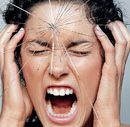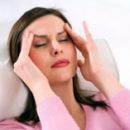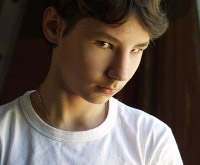Schizophrenia - a disease having a biological nature, its manifestations can be eliminated by exposure to the exchange of biologically active substances in the brain.
Content
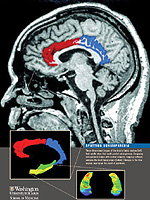 Since the discovery in the 50s of the 20th century, the first psychotropic drug of the aminazin occurred a revolution in the field of mental disorders, especially schizophrenia. Until this time, the most popular methods of schizophrenia were insulin therapy, electrosalproof therapy and lobotomy. Medical treatment was more aimed at eliminating certain symptoms of the disease and usually included soothing drugs.
Since the discovery in the 50s of the 20th century, the first psychotropic drug of the aminazin occurred a revolution in the field of mental disorders, especially schizophrenia. Until this time, the most popular methods of schizophrenia were insulin therapy, electrosalproof therapy and lobotomy. Medical treatment was more aimed at eliminating certain symptoms of the disease and usually included soothing drugs.
With the advent of neuroleptics, it was possible to be chemically influenced and eliminated symptoms of the disease, whereas previously such patients had to be isolated from society waiting for short-term spontaneous remissions.
Modern pharmacology has moved greatly forward and today there is a rather extensive set of drugs, in varying degrees affecting schizophrenia symptoms. These drugs got a name «Neuroleptics» or «Antipsychotics». In general, they have one - they all first eliminate the manifestations of psychosis: nonsense, hallucinations, psychomotor arousal.
The mechanism of their action is the blockade of receptors to the biologically active substance of the brain of the dopamine, due to this and the antipsychotic effect of drugs occurs. In addition, they have affinity and to other receptors (to acetylcholine, adrenaline, serotonin, histamine), which explains a rather wide range of their actions and the emergence of some side effects.
There are many classes of neuroleptics, which differ in the chemical structure, which means they affect the organism in different ways, to a greater or lesser extent affecting various manifestations of schizophrenia.
The antipsychotic effect of neuroleptics is distinguished: general is the impact on all manifestations of psychosis and preventing the further development of the disease, and selective - targeted effect on nonsense, hallucinations, obsessive states, catatonia. Due to the sedative (braking) action of neuroleptics are effective in various types of psychomotor arousal and insomnia. Some neuroleptics on the contrary inherent in the activating effect, it is used in the treatment of apathy, catatonic stupor, autism.
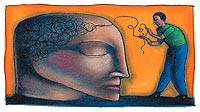 Cognitive action is an effect on the highest functions of the cerebral cortex (memory, attention, thinking, perception). Neuroleptics also have a neurological effect - associated with dopamine receptors, which are located in the regulation centers of movements, which causes such side effects as muscle stiffness, non-frequency, trembling limbs. These undesirable phenomena are eliminated by the appointment of proofreaders, such as cyclodol or Akinton.
Cognitive action is an effect on the highest functions of the cerebral cortex (memory, attention, thinking, perception). Neuroleptics also have a neurological effect - associated with dopamine receptors, which are located in the regulation centers of movements, which causes such side effects as muscle stiffness, non-frequency, trembling limbs. These undesirable phenomena are eliminated by the appointment of proofreaders, such as cyclodol or Akinton.
Neuroleptics also affect the vegetative nervous system and the endocrine system, which can manifest dryness in the mouth, urination delay, decrease in blood pressure, decrease in sexual waste, disruption of the menstrual cycle, increasing body weight. In different groups of neuroleptics, the listed effects are expressed in varying degrees, and the use of one or another class of drugs depends on the form of schizophrenia and the features of its flow.
Last time, preference is given to the modern class of neuroleptics, which appeared in the 90s of the XX century, the so-called «atypical» Neuroleptic. They are atypical because, unlike the preparations of former generations, they practically do not possess the neurological effect, t.E. do not cause side effects associated with motor disorders. This is a very valuable quality, as motor disorders usually deliver great discomfort to patients and require the appointment of additional proofreaders.
At the same time, modern neuroleptics are as effective in eliminating schizophrenia symptoms, like old drugs. Another advantage of atypical neuroleptics is their positive effect on cognitive functions (clangtotropic effect), which was not in the preparations of past years. In addition, due to the binding to the serotonin brain receptors, atypical neuroleptics also have the effect of antidepressants.
Modern drugs are convenient for use - the features of their distribution in the body are such that they can be taken only once a day. With regular reception, drugs begin to act completely in 2-3 weeks, so they must be continued to take, even if at first glance and there is no expected effect. However, at the peak of the drug, not all symptoms of the disease can be immediately eliminated - for the complete disappearance of symptoms and to prevent the recurrence of the drug disease, you need to drink on average for two years.
For the convenience of long-term use of drugs, forms of neuroleptics of long-term action in the form of injections (rispolept concrete) - one such injection is enough for 2-4 weeks.
In addition to the elimination of specific schizophrenic symptoms, it is useful to carry out a lining treatment, since the disease is usually accompanied by common impaired from the nervous system. For this purpose, drugs are used, improving metabolism in the nervous tissue: Picconal, Mexidol, Cerebrolysin, Milgama, Mildranat, Glyatillin, Nootropyl.
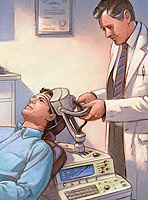 The main problem that may occur in the treatment of schizophrenia is resistance to drugs. This phenomenon is rare, however, may occur with certain schizophrenia forms, the peculiarities of the metabolism in a patient or long and inadequate treatment with psychotropic agents. In such cases, as well as for the breakdown of sharp attacks of schizophrenia with nonsense and catatonia, electrosalize therapy (EST), insulin coatous therapy, hemosorption and plasmapheresis, laser irradiation of blood use.
The main problem that may occur in the treatment of schizophrenia is resistance to drugs. This phenomenon is rare, however, may occur with certain schizophrenia forms, the peculiarities of the metabolism in a patient or long and inadequate treatment with psychotropic agents. In such cases, as well as for the breakdown of sharp attacks of schizophrenia with nonsense and catatonia, electrosalize therapy (EST), insulin coatous therapy, hemosorption and plasmapheresis, laser irradiation of blood use.
Sessions of electrosusproy therapy are carried out under conditions of resuscitation unit under general anesthesia, to minimize the risk of complications. On the patient's head impose electrodes and artificially cause convulsive fit. The course of treatment includes 4-8 sessions of EST, patients fully forget the seizures, and the effectiveness of this method can be quite significant.
Another way of shock therapy of schizophrenia is insulinsomatous therapy. This technique is based on the introduction of insulin doses to achieve the hypoglycemic coma (loss of consciousness due to reduction of blood sugar). 10-20 minutes after reaching the coma of the patient, it is removed from it by intravenous administration of glucose solution. In order to break the attack of psychosis, 10-20 sessions are required.
Sometimes it is an effective use of detoxification (purification from toxins) of the body using hemosorption or plasmferresis. The blood of the patient is driven through a special apparatus, where it is cleared of toxins, immune complexes, in the case of long-term therapy with drugs - from medicinal substances. This can contribute to both the decrease in schizophrenic symptoms and overcoming resistance to drugs due to «cleansing» receptors. Blood irradiation with a laser has a similar effect.
Listed methods of the so-called «irrelicious» Therapies are used in extreme cases of intolerance, drug resistance or for breaking acute psychosis. In all other things there are enough drug therapy. Also for greater efficiency it is possible a combination of drug therapy with glorious treatment methods.
With the current development of psychiatry, when it is possible to conduct therapy with modern drugs, with timely appeal to the doctor (no later than 2 years after the emergence of the first signs of the disease), when appropriate drug therapy and compliance with the treatment of drugs, it is possible to carry out effective treatment with a minimum of side effects, with eliminating schizophrenic symptoms and defects that the disease managed to cause patient personality.
With a long time of the current disease it is possible to achieve a significant improvement in the state and prevent further development of the painful process. At the same time, one biological therapy for the effective treatment of schizophrenia is clearly not enough and the mandatory conduct of psychotherapy (individual, group, family), psychological correction of memory violations, attention, thinking, as well as a complex of social events aimed at rehabilitation of a person suffering from this disease.

